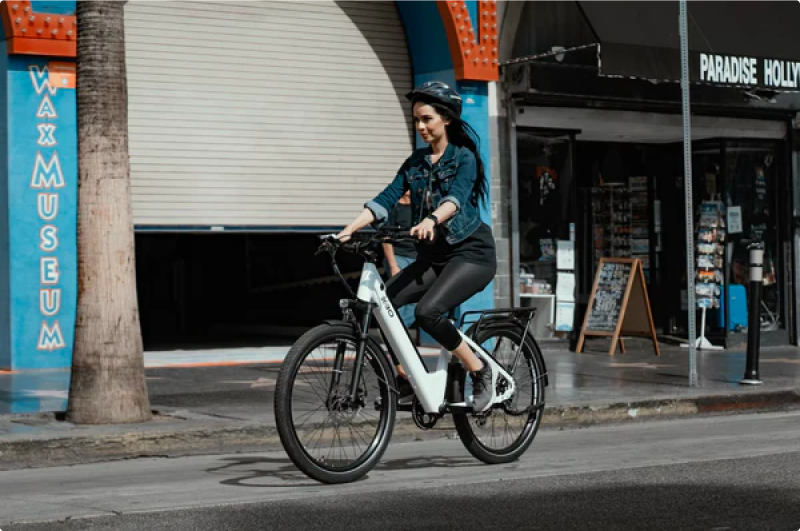For good reasons, commuters are choosing cycling as a form of transportation more frequently. Cycling is not only a fantastic method to increase physical fitness and lower stress levels, but it can also be a quick, cheap way to get to work.
Despite these benefits, most people are still undecided about cycling for their daily commute since they fear they won’t get to work on time. However, this is not the case. With the right planning and the right cycling accessories, you can get to work on time while cycling… all while enjoying its health and economic benefits.
What are the advantages of cycling to work every day?
Cycling has numerous fitness benefits, and it would not hurt to enjoy them daily at your workplace.
Cycling makes you physically and holistically healthier. Cycling is a terrific method to strengthen your muscles, boost your general fitness level, and improve your cardiovascular health. Aside from this, it also has numerous mental health benefits, such as decreasing stress. Cycling gives you a sense of independence and a chance to unwind, which can help reduce tension. By easing the symptoms of anxiety and depression, cycling can also favor your mental health.
A healthier body and mind can also boost your productivity. According to studies, those who bike to work are more productive, focused, and invigorated all day long. It helps you connect with people better. You can bond with your colleagues while cycling and make friends with other bikers in your neighborhood, which can be done by cycling to work.
Aside from this, tracking your heart rate, exhaustion level, and your body’s capacity to hit your goals with your new physical activities is also best. You could consult a professional like your training coach or doctor to check your new lifestyle habits.

On the economic side, cycling every day would help you save money. Compared to driving or public transit, cycling to work is a cost-effective option. Gas, parking, and other transportation costs will be less expensive for you. During rush hour, riding to work may actually be faster than taking a car or public transportation, depending on your journey.
And because you’re not riding a car to work every day, cycling to work will help you leave a smaller carbon footprint, improving the sustainability of the environment.
In short, your decision to go cycling to work pretty much helps you and everyone around you!
Can you make it to work on time by cycling?
Depending on a number of variables, like the distance you must go, your riding speed, and the route you take, cycling can unquestionably help you arrive at work on time.
Cycling can sometimes be faster than driving or using public transportation, especially during rush hour or in crowded cities where traffic jams can result in lengthy delays. Also, you won’t have to worry about parking or being stopped in traffic when you cycle.

Nonetheless, it’s crucial to plan your trip in advance and consider any potential snags like weather-related delays or road closures. Giving yourself enough time to get ready and get ready for your journey is also vital, especially if you need to take a shower and change into a different outfit when you get to work.
Overall, cycling can be a practical and effective form of transportation that will enable you to go to work on time and experience less stress while doing so.
How can you arrive at your workplace on time by cycling?
Here are some guidelines you may use to make sure you cycle to work on time:
1. Plan the optimal route to your workplace
In our previous blog, we discussed how to find the most optimal route to your workplace. You must take this task seriously if you want to arrive on time while cycling.
Planning a route to your work would require you to go through multiple locations, test various routes, and examine your riding habits. Yes, it sounds really challenging, but all of these necessary steps would allow you to save time and money on your next rides.
Fortunately, there are now GPS trackers and navigation apps that can cut your planning time by half. They can show you satellite versions of various locations, so you can do an initial analysis before including it in your initial routes. Furthermore, the GPS trackers would allow you to accurately track your riding time and power output. This will not just give you the most optimal time for your everyday ride, but it will also ensure that you don’t overexert yourself on your daily commute.
2. Be prepared for emergencies
Consider any potential barriers like road closures, construction, or bad weather while choosing a efficient and safe route. To assist you in planning your trip, think about utilizing a bicycle map or app. Furthermore, it’s best to have a top-post bag with basic repair tools such as a handy wrench and a mini travel pump. You’ll never know when you will need these tools.
Give yourself extra time to get ready and get ready for your journey, especially if you need to take a shower and change into a different outfit when you get to work. To allow for unforeseen delays, choose a departure time that is a few minutes sooner than you would if you were driving or using public transportation.
3. Check your gears and your cycling accessories
Before you start riding, inspect your bike to ensure it is in good functioning condition. Check the chain, tires, gears, brakes, and other components to ensure they operate properly.
Furthermore, you should prioritize getting a high-quality bike. While there are lots of single-speed commuter bikes available in the market today, it’s best to go for a premium cyclocross bike. A single-speed bike without gears would force you to depend on your power output to achieve the ideal speed. On the other hand, cyclocross bicycles would allow you to maximize inclination, descent, and other road features to increase your speed without using too much of your energy.
Most importantly, ensure that your gears are made of premium materials and would not be easily worn off since you’re most likely to use them every day. Sure enough, you wouldn’t want to replace your bike every other month.
4. Dress properly
Your comfort can dictate your riding habits. When you’re comfortable while riding, you can easily pick up your pace and increase your speed without overexerting yourself. On the other hand, if you’re uncomfortable, a slight ascent on the road can exhaust you. Not to mention it can also cause faulty maneuvering, which may lead to accidents.
Make sure you’re dressed correctly for the weather by following these tips. Wear layers of loose-fitting, breathable clothing that allows you to move freely. This will allow you to easily modify your attire as necessary.
5. Use reflectors and lights
Major cities now require a combination of front lights and brake lights. So, when cycling to work, it’s best to have both so you can comfortably navigate any alternative roads without getting a ticket.
Aside from this, using lights can also reduce your chances of getting into a road accident as it makes you visible to other cyclists and drivers. Some bike lights even come with GPS tracking, which you can use to navigate roads seamlessly.

6. Follow traffic rules and regulations
Observe the rules of the road and pay attention to your surroundings. Always abide by traffic laws. Turn with caution, abide by traffic signs, and keep an eye out for any potential dangers like potholes, gravel, or other impediments.
These suggestions can help you have a safe and pleasurable commute while cycling and help you get to work on time.
To sum up
The bottom line is that cycling is a great way to get to work while also enhancing your health, lowering your carbon footprint, and saving money. Even in crowded urban locations, biking to work can be a dependable and effective way to get there on time, albeit it does involve some planning and preparation.
You may have a smooth and stress-free ride to work by adhering to safety best practices for cyclists, such as dressing appropriately, inspecting your bike before riding, obeying traffic regulations, and, most importantly, planning the best route. It’s no surprise that more and more individuals are opting to commute by bike, given the various advantages of cycling, from increasing physical fitness to lowering stress levels. So why not give it a shot and experience the joys of cycling to work on time?
